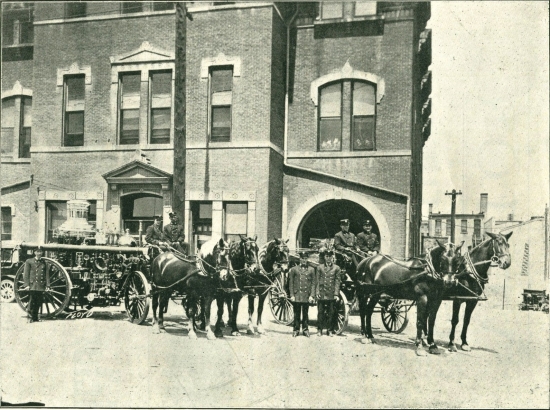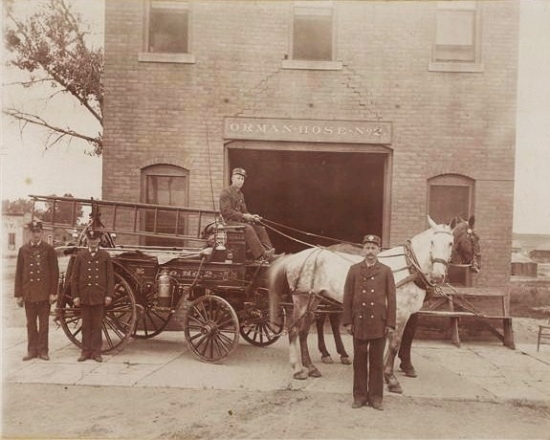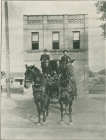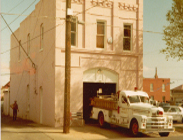The Professional
PUEBLO
FIRE
DEPARTMENT
- History -
1889
Throughout the spring and summer of 1889, the Pueblo city council were busy preparing to upgrade to a paid fire department. Instead of the hand pulled hose carts, the new department would use horse-drawn wagons, and a new horse-drawn hook and ladder truck. They also made plans to purchase two horse drawn steamers, though they ended up getting one initially. Chief Robert J. Krague was the chief of the volunteer department, who still provided the fire protection in the growing city. Chief Krague worked with the city council in getting prices on the various equipment. They decided on an steamer engine from the Ahrens Co. (a size 2 piston pump costing $4,000) that arrived in September. They also got bids from the Silsby Co. and the LaFrance Co. for a steamer. The two hose wagons and the hook and ladder truck were purchased from the E. P. Preston Co. of Chicago, and arrived in Pueblo on July 29th. The hose wagons cost $1,200 apiece (without hose or nozzles), and the aerial ladder truck was $3,150 (with a full compliment of ground ladders).
On October 1st, 1889, the fire department officially became a professional department, under the guidance of Fire Chief Robert J. Krague and Asst. Fire Chief Tris D. Sanborn. The fire department headquarters was in City Hall at 123 Central Main St. The city had also established a very good water supply system with over 40 fire hydrants and 24 Gamewell Fire Alarm Boxes around town. The telegraph-based Gamewell boxes notified the base station at the water works building, and a steam whistle would sound the box number. However, the boxes were 7 years old and would short circuit each other if more than one box were pulled at the same time. Chief Krague recommended upgrading the Gamewell boxes to non-interfering ones, though The Pueblo Chieftain was backing the new telephone system. The Gamewell boxes would continue being used until 1980.
They also purchased horses, which several aldermen went on trips to Denver, Kansas City, and St. Louis to find them. They purchased a set of two gray horses (from Denver) to pull the James Rice Hose Co. No. 1 (which was the name of the original hose company of Pueblo Volunteer Fire Dept. in 1874.). They named the horses after Aldermen "Jack" (Hogan) and "Tom" (Lloyd). The Rice Hose No. 1 was housed in the old Pueblo City Hall building at 616 N. Main St. The paid fireman for the Rice Co. were George W. Hook (who would become the third chief of the department,) Captain; A. E. Neagle, Driver; Frank Smith and William Corbert, Firemen.
Fire Station No. 1, which housed the Hose Co. No. 1 and the Hook & Ladder Co. (shown here).
The steamer company was named the A. T. Stewart Steamer Co. No. 1 (named after Alderman A. T. Stewart). The two light brown horses were purchased in St. Louis and weighed about 1,550 pounds each. The Stewart Steamer Co. was housed in the City Hall at 123 Central Main St. with the Chief's buggy. The paid firemen on the steamer were Abe Gutshall, Engineer; Cicero Weidner and James McGovern, Firemen.

The Central Station at 123 Central Main St. with Engine 1 and the Chief's buggy.
The second hose company was the J. B. Orman Hose Co. No. 2 (which was the name of the original hose company of the South Pueblo Volunteer Fire Dept. in 1880). It only mentions that the horses were purchased locally. The Orman Hose No. 2 were housed in the old South Pueblo City Hall building at 109 E. C Street. The paid firemen for the Orman Co. were Henry Jamison (a former chief of the South Pueblo V. F. D. who was also training the horses to pull the hook and ladder truck), Captain; John Petell, Driver; Frank M. Thomas (who would be Chief Sam Christy's assistant chief from 1911 until 1921) and Joseph Schultz, Firemen.
The Orman Hose Co. No. 2 at the old South Pueblo City Hall.
Within a few months, another hose company was added "on the Mesa". A wooden hose house was constructed on the alleys of Broadway & Michigan and Abriendo & Evans (behind 116 Broadway, they had alleys crossing both ways then). This was the Mesa Hose Co. No. 3 and Joseph Schultz was the first captain. In 1891, Krague and Sanborn were re-appointed to the chief's positions (a fire chief & asst., a police chief & asst., and a town marshal were appointed after each mayoral election, which occured every two years. This practiced continued until the creation of the city's civil service commission in 1911. They had 9 chiefs in the first 22 years,and it would take the department 74 years to have another 9 chiefs.) By 1891, the Hook & Ladder Co. moved to 616 N. Main St. with Hose Co. No. 1. Tragically, Chief Krague was killed on July 31, 1891 while practicing with his buggy. Asst. Chief Sanborn took over as chief, and J. F. Campbell was appointed assistant chief by the city council. Sanborn added a Chemical Co. to the department that was housed at the City Hall on Central Main with the steamer company. He also moved Hose Co. No. 2 to 231 Victoria Ave. by 1893. The Orman Hose Co. No. 2 were the only ones still using the person's name in the company, as you can see in the pictures below.

The Orman Hose Co. No. 2 at 231 Victoria Ave. in 1893.
By 1914, the department had become fully motorized, and was under the guidance of Chief Sam Christy, one of the most progressive chiefs in the country at the time.
The hook and ladder company was called the A. A. Grome Hook & Ladder Co. No. 1 (named after Alderman A. A. Grome). The bay horses came from Kansas City, weighed 1,400 pounds apiece and were named after Aldermen "A. T." (Stewart) and "George" (Alden). The paid firemen for the H. & L. Co. were Clarence Patterson, Captain; George S. Bailey, Driver; Jack Dawson, Tillerman; John Campbell and I. Reed, Firemen.
The steamer company was named the A. T. Stewart Steamer Co. No. 1 (named after Alderman A. T. Stewart). The two light brown horses were purchased in St. Louis and weighed about 1,550 pounds each. The Stewart Steamer Co. was housed in the City Hall on Central Main St. with the H. & L. Company. The paid firemen were Abe Gutshall, Engineer; Cicero Weidner and James McGovern, Firemen.


